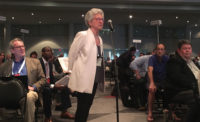A free digital design tool that can help reduce the carbon footprint of a site is putting climate-friendly landscape architecture on a better path.
“There is so much guidance, standards and metrics for buildings and very little for outside the buildings,” says Pamela Conrad, a principal with CMG Landscape Architecture and founder of Climate Positive Design, an initiative that launched the carbon-accounting tool last year. “There was no way for us to measure what we were doing.”
So Conrad filled the gap. She used a $25,000 fellowship from the Landscape Architecture Foundation for initial development of Pathfinder, a web-based app. The funds went toward a web consultant, an app designer and an environmental consultant for third-party verification.
In September, an expanded Pathfinder, which is based largely on environmental product declarations, came out. It contains additional materials and carbon sequestration data. It allows users to compare design alternatives and consider more site impacts, such as tree removal and soil disturbance.
Using the tool, CMG was able to tweak its initial design of a plaza to become carbon positive in 20 years instead of 194 years. This was done by converting 20% of the concrete to shrubs, changing 2,000 sq ft of stone to stabilized crushed stone, converting 10% of the concrete to stabilized decomposed granite, changing concrete walls to wood, adding cement substitutes to the concrete and adding 14 trees.
“The tool is amazing,” says Karema Seliem, sustainable sites subject-matter expert for the U.S. Green Building Council’s LEED rating system, which contains a sustainable sites credit.
Currently, Conrad is helping craft a LEED carbon-sequestration pilot credit. “She’s helping us develop the language because she’s the expert,” says Seliem.






Post a comment to this article
Report Abusive Comment